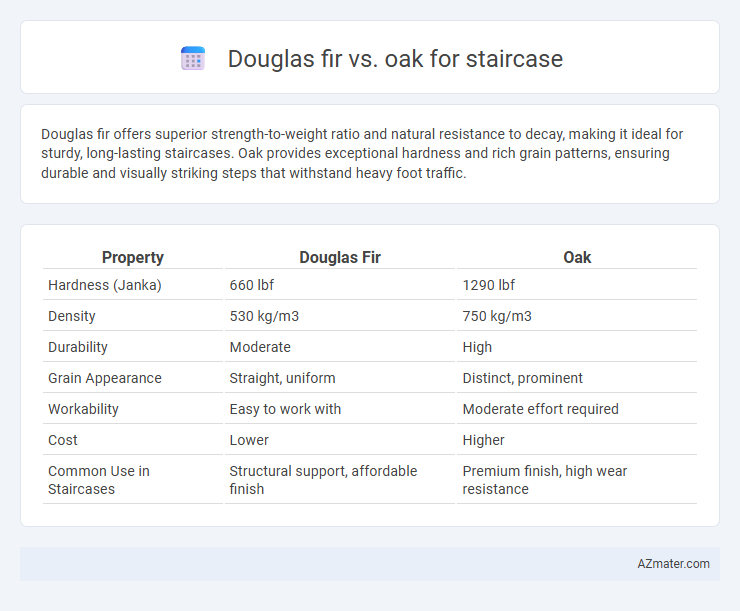Douglas fir offers superior strength-to-weight ratio and natural resistance to decay, making it ideal for sturdy, long-lasting staircases. Oak provides exceptional hardness and rich grain patterns, ensuring durable and visually striking steps that withstand heavy foot traffic.
Table of Comparison
| Property | Douglas Fir | Oak |
|---|---|---|
| Hardness (Janka) | 660 lbf | 1290 lbf |
| Density | 530 kg/m3 | 750 kg/m3 |
| Durability | Moderate | High |
| Grain Appearance | Straight, uniform | Distinct, prominent |
| Workability | Easy to work with | Moderate effort required |
| Cost | Lower | Higher |
| Common Use in Staircases | Structural support, affordable finish | Premium finish, high wear resistance |
Introduction to Douglas Fir and Oak for Staircases
Douglas fir is a strong and durable softwood commonly used in staircase construction due to its straight grain and resistance to wear, offering a smooth finish ideal for both modern and traditional designs. Oak, a dense hardwood, is favored for staircases because of its exceptional hardness, rich grain patterns, and long-lasting durability, making it suitable for high-traffic areas. Both woods provide structural integrity and aesthetic appeal, with Douglas fir often chosen for cost-effectiveness and oak preferred for premium, classic staircases.
Appearance and Grain Patterns
Douglas fir displays a warm, reddish-brown hue with straight, tight grain patterns that create a sleek, uniform appearance ideal for modern staircases. Oak features a distinctive coarse and prominent grain with a light to medium brown color, often showcasing dramatic swirls and knots adding rustic charm and character. The choice between Douglas fir and Oak hinges on preference for subtle elegance versus bold, textured visual impact in staircase design.
Strength and Durability Comparison
Douglas fir offers exceptional strength and a high strength-to-weight ratio, making it ideal for staircases that require robust support and resistance to bending. Oak, particularly white oak, provides superior hardness and durability, with high resistance to wear and impact, ensuring long-lasting stair treads in high-traffic areas. Both woods are strong and durable, but Douglas fir excels in structural applications while oak is preferred for its toughness and aesthetic longevity.
Cost Differences: Douglas Fir vs Oak
Douglas fir staircases typically cost less than oak due to the faster growth rate and greater availability of Douglas fir, resulting in lower material prices. Oak, being a hardwood with a dense grain and longer maturation period, commands a higher price, often doubling the cost of Douglas fir. Installation expenses remain comparable, but the overall budget impact favors Douglas fir for cost-conscious staircase projects.
Workability and Ease of Installation
Douglas fir offers superior workability for staircases due to its straight grain and medium hardness, allowing for easier cutting, shaping, and sanding compared to oak. Oak, while highly durable and dense, poses more challenges during installation because of its hardness and tendency to splinter, requiring specialized tools and greater effort for precise fitting. Choosing Douglas fir results in reduced labor time and smoother handling, making it a preferred option for efficient staircase construction.
Finishing and Maintenance Requirements
Douglas fir staircases exhibit a smooth grain that readily accepts stains and finishes, allowing for a versatile range of aesthetic options, from natural clear coats to rich, dark stains. Oak, particularly red oak, is harder and denser, providing exceptional durability and a natural grain pattern that enhances finishes, but it requires more maintenance to prevent surface wear and moisture damage. Both woods benefit from regular sealing and refinishing to maintain appearance, though Douglas fir generally demands less frequent upkeep due to its natural resistance to wear and easier repairability.
Resistance to Wear and Damage
Douglas fir exhibits excellent resistance to wear and damage due to its moderate hardness and flexibility, making it suitable for staircases with moderate foot traffic. Oak, particularly red and white oak, offers superior durability and higher Janka hardness ratings, providing enhanced resistance to dents, scratches, and heavy use over time. For staircases subjected to frequent use and potential impact, oak generally outperforms Douglas fir in maintaining appearance and structural integrity.
Environmental Impact and Sustainability
Douglas fir offers a more sustainable option for staircases due to its faster growth rate and higher availability, which reduces deforestation pressure compared to oak. Oak, although durable and long-lasting, requires longer growth periods and often comes from slower-renewing hardwood forests, resulting in a higher carbon footprint. Choosing certified sources like FSC-certified Douglas fir or oak ensures responsible forestry practices, minimizing environmental impact.
Best Applications: When to Choose Douglas Fir or Oak
Douglas fir is ideal for staircase projects requiring strong durability and moderate aesthetic appeal, especially in modern or rustic interiors where budget-friendly hardwood is needed. Oak excels in applications demanding superior hardness, classic elegance, and intricate grain patterns, making it perfect for traditional or high-end staircases. Choose Douglas fir for structural strength and affordability, while oak suits premium finishes and long-lasting wear in formal settings.
Conclusion: Which Wood is Better for Your Staircase?
Douglas fir offers exceptional strength and a warm, reddish hue, making it ideal for sturdy, visually appealing staircases. Oak provides superior durability and a classic, timeless grain pattern that resists wear and maintains elegance over time. For a long-lasting, high-traffic staircase, oak is generally the better choice, while Douglas fir suits budget-conscious projects emphasizing strength and aesthetics.

Infographic: Douglas fir vs Oak for Staircase
 azmater.com
azmater.com